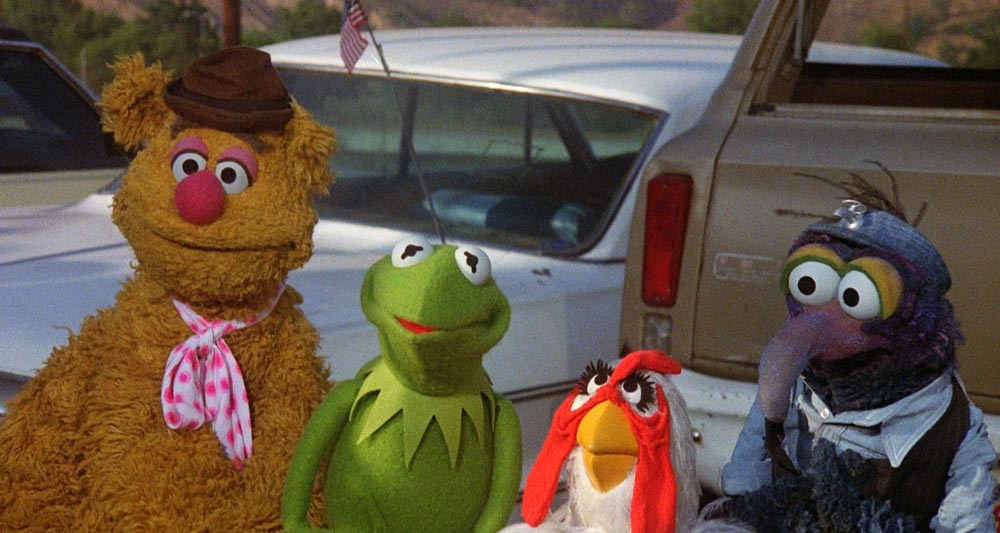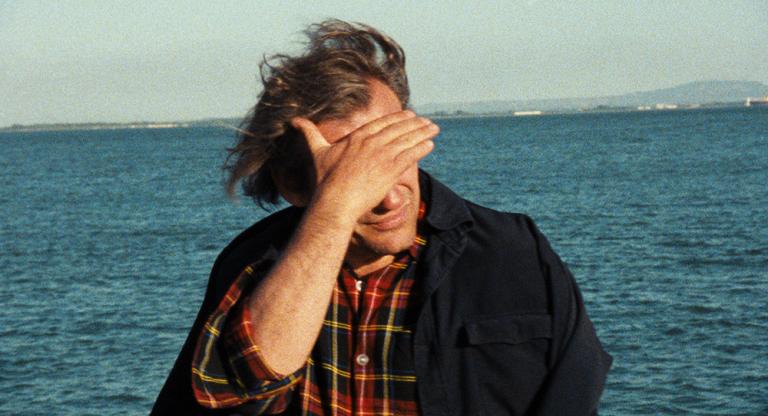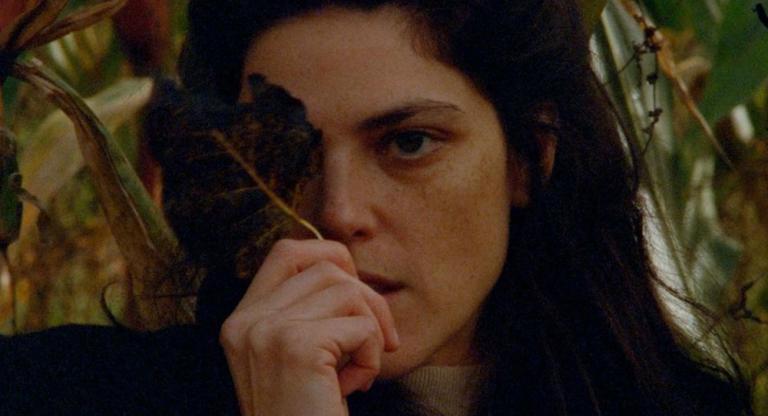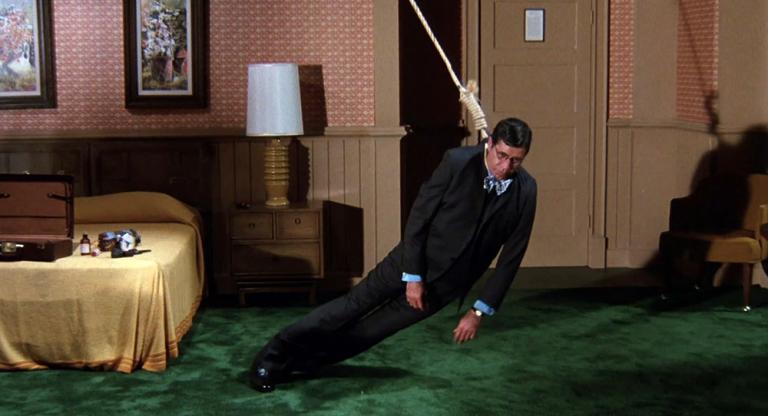The Muppet Movie (1979) is a madcap road movie for children, the first and most effortlessly poetic installment in the Muppet Cinematic Universe, but the film is also something darker. It’s a shaggy 1970s misfits-on-the-lam story in the tradition of Thieves Like Us (1974) and The Sugarland Express (1974), centering on an artist who refuses a product endorsement deal and is chased across the country by a CEO bent on commodifying him. If the broad strokes sound Chayefskian, the specifics are pure gag-hut: the artist is Kermit the Frog, his art is a hybrid of banjo-playing and punning, and his pursuer is Doc Hopper, a fast-food mogul played by Charles Durning whose specialty dish is frog legs and who has the vaguely supernatural ability to anticipate Kermit’s movements from podunk to podunk.
The film is far more visually arresting than it needed to be. Jim Henson’s decision to shoot puppets on practical locations using natural light feels like an avant-garde technical experiment on par with the candlelit interiors in Barry Lyndon (1975), and rather than looking artificial in the California glare, the Muppets hold their own against reality. According to Bonnie Erickson, who ran the Muppet workshop in the 1970s, Henson favored carving character heads from a special foam whose "pores somehow grabbed [the] light" and experimented with using electrostatic charges to make their surface fibers stand on end—the source of Miss Piggy's Dietrich-like glow.
Strangely for a road picture, there are almost no other cars on the road in The Muppet Movie, and the swamps, churches, and windswept ghost towns where the Muppets make pit stops are largely abandoned. While Fozzie Bear memorably bleats “America the Beautiful” at one point, the America on display is a desiccated husk, as if some atomic blast had flattened the globe, leaving behind the only two species hardy enough to survive the fallout: Muppets and middle-aged celebrities.
Later Muppet films would strain to attract viable guest stars, going repeatedly to the well of David Arquette, but here the cameos fall pleasingly along a spectrum, from perfectly hip (Richard Pryor and Steve Martin) to perfectly square (Bob Hope and Edgar Bergen). The film climaxes with an appearance from Orson Welles, somewhat cruelly cast as an omnipotent studio chief at a moment when Welles himself was unemployable as a director and six years from death. Parked in an armchair the size of a pontoon boat, he delivers his sole line of dialogue—“Prepare the standard rich-and-famous contract for Kermit the Frog and company"—with a rueful lilt. Welles, who’d been “puppet struck” since childhood and was a regular viewer of “The Muppet Show,” stated, after working on the film, “There’s only one word for Jim: he’s a genius. Think of Rasputin as an Eagle Scout.”
Like many of Welles’s pronouncements, this sounds great in his Karo Pudding baritone and falls apart as soon as you try to parse it, but I’ll allow that Kermit himself has a Rasputin-like knack for cheating death. Over the course of The Muppet Movie, he is thrown into the blades of a ceiling fan, held at gunpoint, nearly crushed by a steamroller, and subjected to an experimental German lobotomy. Finally, an apoplectic Hopper hires a sharpshooter to kill the frog, intending to stuff his corpse for use in a national ad campaign. In short, he wants to turn Kermit into a puppet.
As a child, I loved it whenever Kermit was imperiled. His limbs seemed built for flailing, his body designed to absorb karate chops. (This is probably why so many children took to teasing Kermit in the unscripted bumper segments on “Sesame Street”: it felt like fair game, part of the schtick.) What was disturbing—at least to me—were scenes like the one in The Muppets Take Manhattan (1984) where Joan Rivers opens a tube of human lipstick and gives Miss Piggy a touch-up. I couldn’t laugh, because I knew that Rivers was permanently damaging the puppet. (While filming a guest appearance on “The Muppet Show,” Bernadette Peters had to be admonished not to kiss the Muppets, because her makeup would stain the fleece. “It’s so hard not to kiss them!” Peters later said. “You try being near a Muppet and not kissing it.”)
Revisiting The Muppet Movie now, I find it harder to relish Kermit’s plight. His obsession with artistic integrity reads as a barely-disguised metaphor for Jim Henson’s own unreconstructed-hippie-in-Hollywood dilemma—what he once described as his “extreme sensitivity to commercialization of the Muppet characters." Indeed, the film’s plot anticipates Michael Eisner's coldblooded pursuit of the Muppets’ IP in the late 1980s, which culminated in a $150 million offer that would have all but indentured Henson to the Walt Disney Company for 15 years. They were still in negotiations when Henson died, in May 1990, of septic shock caused by a streptococcal bacteria infection. Decades later, Frank Oz claimed, “The Disney deal is probably what killed Jim. It made him sick.” Where Doc Hopper lost, Eisner won. Today the Muppets do commercials for Geico and DoorDash; their most recent TV special was brand maintenance for a theme-park ride.
To say that Jim Henson’s successors, when it comes to playing Kermit, have not gone as deep isn’t merely an aesthetic or a spiritual judgment; it’s an anatomical fact. Henson had inordinately long fingers, which made his puppets hard to build and his manipulation of them singularly expressive. (When the puppeteer Dave Goelz played a dream double of Kermit for a shot late in The Muppet Movie, he had to wear gloves with finger extensions.) As much as I love “The Rainbow Connection,” the most moving things in The Muppet Movie for me are all tactile: the persuasively organic ripple of Kermit’s lips when he enunciates the word “alligator,” or the way he trembles slightly when homing in on Miss Piggy for a smooch. To quote the writer Adela Rogers St. Johns, lusting after Clark Gable in a 1970s documentary: “He was so terribly alive.”
The Muppet Movie screens tomorrow, September 2, at the Museum of the Moving Image as part of “Jim Henson’s World.”



